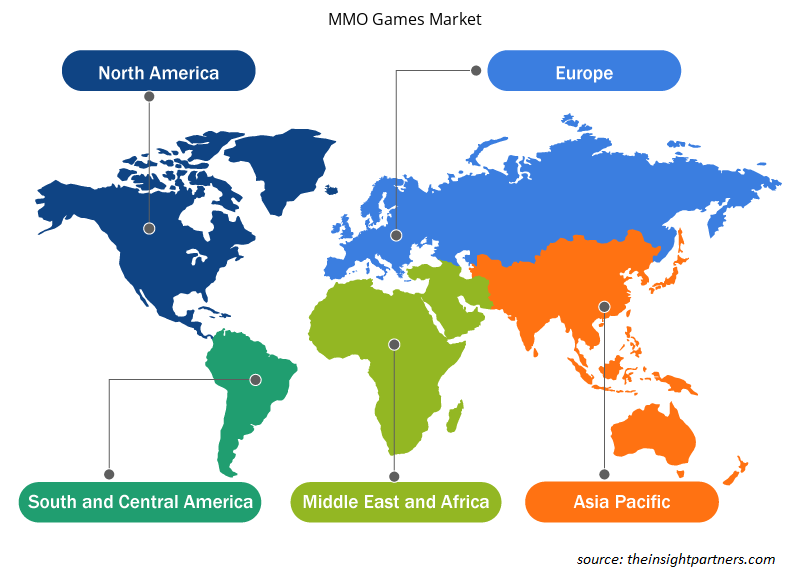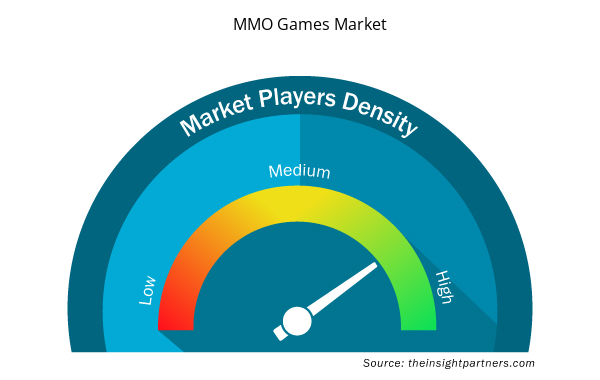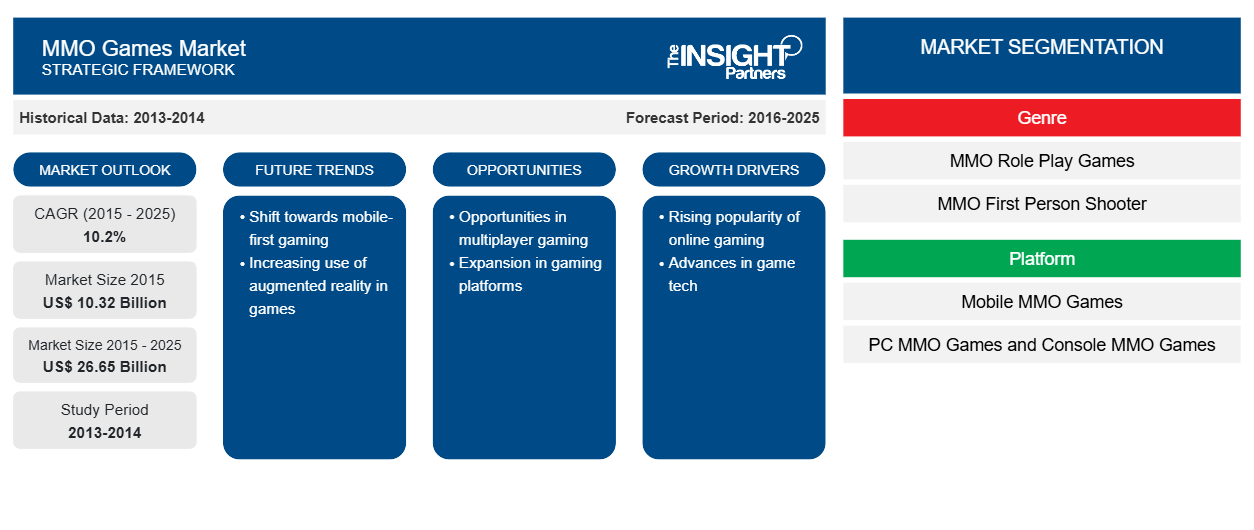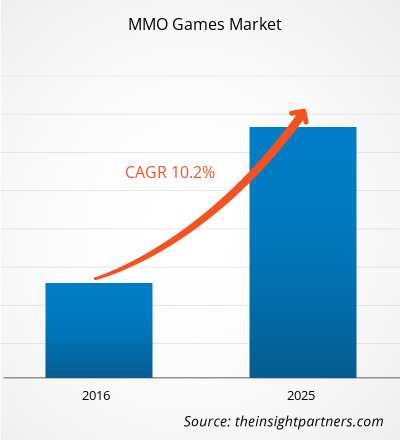Der Markt für MMO-Spiele soll von 10,32 Milliarden US-Dollar im Jahr 2015 auf 26,65 Milliarden US-Dollar im Jahr 2025 wachsen, was einer durchschnittlichen jährlichen Wachstumsrate (CAGR) von 10,2 % zwischen 2015 und 2025 entspricht.
Auch im Bereich der Massively Multiple Online Gaming (MMOG) ist dieser Markttrend zu beobachten, bei dem Spieldesignstrategien zur Optimierung der Benutzerinteraktion eingesetzt werden. Dies wird allgemein als Gamification bezeichnet. Das Aufkommen von Gamification hat zur Schaffung virtueller Welten für die Spieler geführt, in denen sie mit virtueller Wirtschaft, Handel, Währung und Echtzeitsituationen konfrontiert werden. Mithilfe von Gamification gelingt es den Entwicklern, die Spieler bei der Stange zu halten und sie dazu zu bringen, mehr echtes Geld auszugeben, um von den Vorteilen der Spiele zu profitieren. Diese Strategie hat es den Entwicklern und Herausgebern von MMO-Spielen auch ermöglicht, mehr Umsatz zu erzielen, indem sie alte Spieler halten und andere Leute dazu bringen, sich an diesen Spielen zu beteiligen.
Der Bericht zum MMO-Game-Markt konzentriert sich auf eine detaillierte Segmentierung dieses Marktes nach Genre, Plattform und Umsatzmodell. Die geografische Segmentierung des Berichts umfasst fünf große Regionen, darunter Nordamerika, Europa, Asien-Pazifik (APAC), Naher Osten und Afrika (MEA) und Südamerika (SA). Der regionale Markt wurde weiter nach jeweiligen Ländern aufgespalten. Nach Umsatzmodell hatte der Free-to-Play-Gaming-Markt 2015 den größten Anteil am MMOG-Markt; während die Region APAC im Prognosezeitraum voraussichtlich mit der höchsten durchschnittlichen jährlichen Wachstumsrate wachsen wird.
Passen Sie diesen Bericht Ihren Anforderungen an
Sie erhalten kostenlose Anpassungen an jedem Bericht, einschließlich Teilen dieses Berichts oder einer Analyse auf Länderebene, eines Excel-Datenpakets sowie tolle Angebote und Rabatte für Start-ups und Universitäten.
- Holen Sie sich die wichtigsten Markttrends aus diesem Bericht.Dieses KOSTENLOSE Beispiel umfasst eine Datenanalyse von Markttrends bis hin zu Schätzungen und Prognosen.
Der Bericht zum MMO-Spielemarkt soll einen Überblick über den globalen MMOG-Markt mit detaillierter Marktsegmentierung bieten. Außerdem analysiert er das aktuelle Szenario des MMO-Spielemarkts und prognostiziert den Markt bis 2025. Der Bericht deckt die Marktdynamik ab, die den Markt während des Prognosezeitraums beeinflusst. Darüber hinaus analysiert der Bericht das Wettbewerbsszenario, die geografischen Trends und die Marktchancen in Bezug auf alle geografischen Regionen. Der Bericht zum MMO-Spielemarkt enthält auch die detaillierten Unternehmensprofile der wichtigsten Akteure auf dem Markt sowie deren Marktstrategien. Der Bericht enthält auch Porters Fünf-Kräfte-Analyse und SWOT-Analyse für alle im Bericht profilierten Unternehmen.
Unternehmen wie Activision Blizzard und Electronic Arts beteiligen sich massiv an Medien- und Werbeveranstaltungen, die zu einem weiteren Anstieg der Bekanntheit und des Konsums der Spiele führen. Einige der anderen Faktoren, die das Wachstum dieses Marktes beeinflussen, sind das Wachstum bei der Entwicklung von Hardwareplattformen wie PlayStation, XBOX360 und Wii U. Aufkommende Gamifizierung und virtuelle Währungen sind ebenfalls einige der Faktoren, die das Wachstum des MMO-Spielemarkts während des Prognosezeitraums beeinflussen.
Regionale Einblicke in den MMO-Spielemarkt
Die regionalen Trends und Faktoren, die den MMO-Spielemarkt im Prognosezeitraum beeinflussen, wurden von den Analysten von Insight Partners ausführlich erläutert. In diesem Abschnitt werden auch MMO-Spielemarktsegmente und -geografie in Nordamerika, Europa, im asiatisch-pazifischen Raum, im Nahen Osten und Afrika sowie in Süd- und Mittelamerika erörtert.

- Holen Sie sich regionale Daten zum MMO-Spielemarkt
Umfang des MMO-Spiele-Marktberichts
| Berichtsattribut | Details |
|---|---|
| Marktgröße im Jahr 2015 | 10,32 Milliarden US-Dollar |
| Marktgröße bis 2025 | 26,65 Milliarden US-Dollar |
| Globale CAGR (2015 - 2025) | 10,2 % |
| Historische Daten | 2013–2014 |
| Prognosezeitraum | 2016–2025 |
| Abgedeckte Segmente | Nach Genre
|
| Abgedeckte Regionen und Länder | Nordamerika
|
| Marktführer und wichtige Unternehmensprofile |
|
Marktteilnehmerdichte: Der Einfluss auf die Geschäftsdynamik
Der Markt für MMO-Spiele wächst rasant. Die Nachfrage der Endnutzer steigt aufgrund von Faktoren wie sich entwickelnden Verbraucherpräferenzen, technologischen Fortschritten und einem größeren Bewusstsein für die Vorteile des Produkts. Mit der steigenden Nachfrage erweitern Unternehmen ihr Angebot, entwickeln Innovationen, um die Bedürfnisse der Verbraucher zu erfüllen, und nutzen neue Trends, was das Marktwachstum weiter ankurbelt.
Die Marktteilnehmerdichte bezieht sich auf die Verteilung der Firmen oder Unternehmen, die in einem bestimmten Markt oder einer bestimmten Branche tätig sind. Sie gibt an, wie viele Wettbewerber (Marktteilnehmer) in einem bestimmten Marktraum im Verhältnis zu seiner Größe oder seinem gesamten Marktwert präsent sind.
Die wichtigsten auf dem MMO-Spielemarkt tätigen Unternehmen sind:
- Activision Blizzard, Inc.
- Electronic Arts (EA)
- Giant Interactive Group Inc.
- NCSOFT Corporation
- Ankama
Haftungsausschluss : Die oben aufgeführten Unternehmen sind nicht in einer bestimmten Reihenfolge aufgeführt.

- Überblick über die wichtigsten Akteure auf dem MMO-Spielemarkt
Zu den wichtigsten Akteuren auf dem MMO-Spielemarkt gehören
- Activision Blizzard, Inc.
- Electronic Arts (EA)
- Giant Interactive Group Inc.
- NCSOFT Corporation
- Ankama, NEXON Co., Ltd.
- Gamigo AG
- Tencent Holdings Limited
- Jagex Games Studio
- Ubisoft Entertainment SA
- Historische Analyse (2 Jahre), Basisjahr, Prognose (7 Jahre) mit CAGR
- PEST- und SWOT-Analyse
- Marktgröße Wert/Volumen – Global, Regional, Land
- Branche und Wettbewerbsumfeld
- Excel-Datensatz


- Analog-to-Digital Converter Market
- Photo Editing Software Market
- Personality Assessment Solution Market
- Online Recruitment Market
- Social Employee Recognition System Market
- Ceiling Fans Market
- Compounding Pharmacies Market
- Artificial Intelligence in Defense Market
- HVAC Sensors Market
- Predictive Maintenance Market

Report Coverage
Revenue forecast, Company Analysis, Industry landscape, Growth factors, and Trends

Segment Covered
This text is related
to segments covered.

Regional Scope
North America, Europe, Asia Pacific, Middle East & Africa, South & Central America

Country Scope
This text is related
to country scope.
Trends and growth analysis reports related to Technology, Media and Telecommunications : READ MORE..
The List of Companies - MMO Games Market
- Activision Blizzard, Inc.
- Electronic Arts (EA)
- Giant Interactive Group Inc.
- NCSOFT Corporation
- Ankama
- NEXON Co., Ltd.
- Gamigo AG
- Tencent Holdings Limited
- Jagex Games Studio
- Ubisoft Entertainment SA
The Insight Partners performs research in 4 major stages: Data Collection & Secondary Research, Primary Research, Data Analysis and Data Triangulation & Final Review.
- Data Collection and Secondary Research:
As a market research and consulting firm operating from a decade, we have published and advised several client across the globe. First step for any study will start with an assessment of currently available data and insights from existing reports. Further, historical and current market information is collected from Investor Presentations, Annual Reports, SEC Filings, etc., and other information related to company’s performance and market positioning are gathered from Paid Databases (Factiva, Hoovers, and Reuters) and various other publications available in public domain.
Several associations trade associates, technical forums, institutes, societies and organization are accessed to gain technical as well as market related insights through their publications such as research papers, blogs and press releases related to the studies are referred to get cues about the market. Further, white papers, journals, magazines, and other news articles published in last 3 years are scrutinized and analyzed to understand the current market trends.
- Primary Research:
The primarily interview analysis comprise of data obtained from industry participants interview and answers to survey questions gathered by in-house primary team.
For primary research, interviews are conducted with industry experts/CEOs/Marketing Managers/VPs/Subject Matter Experts from both demand and supply side to get a 360-degree view of the market. The primary team conducts several interviews based on the complexity of the markets to understand the various market trends and dynamics which makes research more credible and precise.
A typical research interview fulfils the following functions:
- Provides first-hand information on the market size, market trends, growth trends, competitive landscape, and outlook
- Validates and strengthens in-house secondary research findings
- Develops the analysis team’s expertise and market understanding
Primary research involves email interactions and telephone interviews for each market, category, segment, and sub-segment across geographies. The participants who typically take part in such a process include, but are not limited to:
- Industry participants: VPs, business development managers, market intelligence managers and national sales managers
- Outside experts: Valuation experts, research analysts and key opinion leaders specializing in the electronics and semiconductor industry.
Below is the breakup of our primary respondents by company, designation, and region:

Once we receive the confirmation from primary research sources or primary respondents, we finalize the base year market estimation and forecast the data as per the macroeconomic and microeconomic factors assessed during data collection.
- Data Analysis:
Once data is validated through both secondary as well as primary respondents, we finalize the market estimations by hypothesis formulation and factor analysis at regional and country level.
- Macro-Economic Factor Analysis:
We analyse macroeconomic indicators such the gross domestic product (GDP), increase in the demand for goods and services across industries, technological advancement, regional economic growth, governmental policies, the influence of COVID-19, PEST analysis, and other aspects. This analysis aids in setting benchmarks for various nations/regions and approximating market splits. Additionally, the general trend of the aforementioned components aid in determining the market's development possibilities.
- Country Level Data:
Various factors that are especially aligned to the country are taken into account to determine the market size for a certain area and country, including the presence of vendors, such as headquarters and offices, the country's GDP, demand patterns, and industry growth. To comprehend the market dynamics for the nation, a number of growth variables, inhibitors, application areas, and current market trends are researched. The aforementioned elements aid in determining the country's overall market's growth potential.
- Company Profile:
The “Table of Contents” is formulated by listing and analyzing more than 25 - 30 companies operating in the market ecosystem across geographies. However, we profile only 10 companies as a standard practice in our syndicate reports. These 10 companies comprise leading, emerging, and regional players. Nonetheless, our analysis is not restricted to the 10 listed companies, we also analyze other companies present in the market to develop a holistic view and understand the prevailing trends. The “Company Profiles” section in the report covers key facts, business description, products & services, financial information, SWOT analysis, and key developments. The financial information presented is extracted from the annual reports and official documents of the publicly listed companies. Upon collecting the information for the sections of respective companies, we verify them via various primary sources and then compile the data in respective company profiles. The company level information helps us in deriving the base number as well as in forecasting the market size.
- Developing Base Number:
Aggregation of sales statistics (2020-2022) and macro-economic factor, and other secondary and primary research insights are utilized to arrive at base number and related market shares for 2022. The data gaps are identified in this step and relevant market data is analyzed, collected from paid primary interviews or databases. On finalizing the base year market size, forecasts are developed on the basis of macro-economic, industry and market growth factors and company level analysis.
- Data Triangulation and Final Review:
The market findings and base year market size calculations are validated from supply as well as demand side. Demand side validations are based on macro-economic factor analysis and benchmarks for respective regions and countries. In case of supply side validations, revenues of major companies are estimated (in case not available) based on industry benchmark, approximate number of employees, product portfolio, and primary interviews revenues are gathered. Further revenue from target product/service segment is assessed to avoid overshooting of market statistics. In case of heavy deviations between supply and demand side values, all thes steps are repeated to achieve synchronization.
We follow an iterative model, wherein we share our research findings with Subject Matter Experts (SME’s) and Key Opinion Leaders (KOLs) until consensus view of the market is not formulated – this model negates any drastic deviation in the opinions of experts. Only validated and universally acceptable research findings are quoted in our reports.
We have important check points that we use to validate our research findings – which we call – data triangulation, where we validate the information, we generate from secondary sources with primary interviews and then we re-validate with our internal data bases and Subject matter experts. This comprehensive model enables us to deliver high quality, reliable data in shortest possible time.


 Holen Sie sich ein kostenloses Muster für diesen Bericht
Holen Sie sich ein kostenloses Muster für diesen Bericht